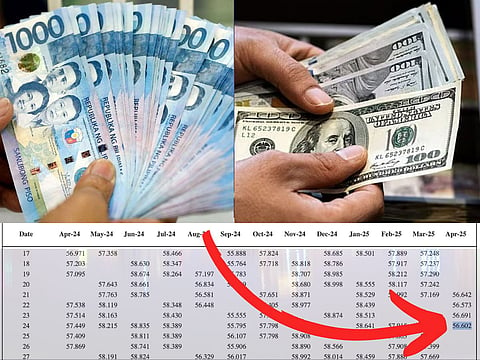Philippine peso rises close to 7-month high: OFWs taking a hit?
Asian currency appreciates amid hopes of easing US-China trade tensions

Manila: The Philippine peso strengthened to a near seven-month high on Thursday (April 24), on hopes of an ease in trade tensions between global economic powers US and China.
The local currency closed at ₱56.602 per US$1, further gaining (8.5 centavos) from Wednesday’s finish of ₱56.691, according to Bangko Sentral ng Pilipinas (BSP) data.
This marked the local currency’s strongest close since October 4, 2024, when it ended at ₱56.295.
This April, the peso average of ₱56.993 vs $1 so far, up nearly 3% compared to the November 2024 average of ₱58.695, as per BSP.
The demand for pesos also remains high: the Asian nation's infrastructure projects are currently valued at more than $106 billion (in progress or in the pipeline).
OFWs get ₱227.20 less for $100
Forex trading volume in the Philippines remains robust: it stood at $1.19 billion on Wednesday, down from $1.46 billion on Tuesday.
Given the resurgent peso, an overseas Filipino worker (OFW) remitting $100 home would receive ₱227.20 less after the peso appreciated from ₱58.874 (on December 23, 2024) to ₱56.602 (on April 24, 2025) per dollar.
BSP data further shows the Asian currency has been on an upward trajectory against the mighty dollar since November 27, 2024, when it touched ₱58.992 vs $1.
Relief from tariff war?
According to a Manila-based trader, investors are responding positively to signs of progress in US-China trade talks, helping lift emerging market currencies like the peso.
Markets also found relief after President Trump stated he has “no intention of firing” U.S. Federal Reserve Chair Jerome Powell, easing fears about political interference in monetary policy.
This reassurance helped stabilise the US dollar, which had been under pressure due to Trump’s past criticisms of Powell for not lowering interest rates.
In addition, both Trump and US Treasury Secretary Scott Bessent suggested that an upcoming US-China trade agreement could result in a “substantial” reduction in tariffs, further calming global markets.
The dollar remains close to multi-year lows against major currencies, including the euro, Swiss franc, and Japanese yen.
Looking ahead, investor sentiment remains focused on whether the US can strike trade deals with China and other key partners.
Trump has temporarily paused steeper import tariffs — set earlier this month — giving 18 countries a chance to negotiate better terms.
Thirty-four nations are set to meet with US officials this week to hammer out deals.
Sign up for the Daily Briefing
Get the latest news and updates straight to your inbox



